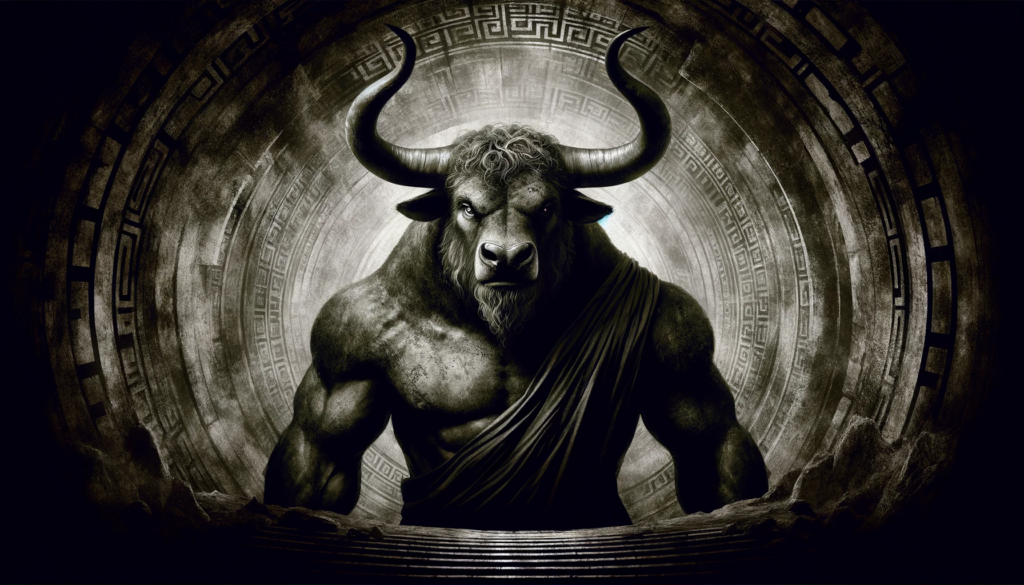The tale of the Minotaur is one of the classics of Greek mythology and contains an extraordinary number of important elements. Characters like the brilliant Daedalus, strong Theseus, evil King Minos and his beautiful daughter Ariadne all make an appearance in this story.
The concept of the labyrinth, or the endless underground maze, also originates in this tale. As with all ancient mythology and folklore, there is no single “correct” version of the story. There is only a mixture of hundreds of different versions of the story, passed down over thousands of years in dozens of languages. However, all tellers of this tale agree on the broad particulars of the events that occurred on the island nation of Crete a long, long time ago.

Who Was The Minotaur?
The story goes that one day the wicked King Minos’s wife gave birth to a son. But the son was born hideously deformed, with a head so twisted and misshapen that it seemed more like the head of an animal. Convinced that his wife must have copulated with a bulls or some other animal behind his back, King Minos flew into a rage and murdered the mother of his son.
However, he could not bring himself to kill the child. Perhaps some part of him knew the truth. Since he could not murder the baby, and he could not admit that it was his son, and he certainly could not bear to see him as a daily reminder of his own cruelty, the King decided to put the child somewhere that no one would ever see him.
But the child was no ordinary child, just as the legendary King Minos was no ordinary King. The child was enormous, supernaturally powerful, bloodthirsty and ravenous. As he grew to tremendous size and began to inflict horrible depredations upon the people of Crete the bull-headed monster became known as the Minotaur. It was obvious to King Minos and his poor subjects that he was far too dangerous to be exiled beyond the city walls.
Containing The Minotaur
The Minotaur could not even be contained secretly within a prison, both because of his enormous strength and because the jailers would be able to see him. Seeking a solution, King Minos turned to one of the most brilliant people of his age, the famous inventor Daedalus.
This is the very same inventor who would later enter Greek mythology with his son Icarus and an ill fated attempt to flee this very same island. But at this time Daedalus had no knowledge of the treachery of King Minos, so he did his bidding and built a prison from which no one could ever escape. Daedalus built the Labyrinth to cage this Minotaur.

The Labyrinth
The Labyrinth was a sprawling underground maze that looped back in on itself, twisted and turned, diverged when least expected and concealed every means of egress with the most cunning tricks that the genius of Daedalus could devise. He built it deep in the rocks beneath the city, and when it was completed they placed the Minotaur within it.
Then they fed the monster all the prisoners of the King. Whenever anyone incurred the King’s displeasure, he simply had them placed in the Labyrinth. They quickly became disoriented and could not escape, and then the Minotaur ate them. Things continued in this fashion for many years, and the floors of the Labyrinth became littered with the skeletons and bones of the lonely Minotaur’s many meals.
Theseus vs Minotaur
One year a young man name Theseus, a warrior from the nearby city-state of Athens, was sentenced to die in the pits of the Minotaur. Instead of meekly going to his fate, he conspired with the gorgeous daughter of King Minos, Ariadne, to kill the Minotaur and end the danger lurking beneath the city. Ariadne brought him two items that he required to complete his quest.
She gave him a sword that he could use to fight the monster and defeat it. In addition, she gave him a ball of yarn. This was so that, once he killed the Minotaur at the heart of the Labyrinth, he could find his way out again.
Theseus moved into the Labyrinth, leaving a single thread of yarn behind him as he went. The Labyrinth was deep, dark and terrifying, and it was not long before Theseus was hopelessly lost.

Crawling along in the subterranean depths, following only the bestial grunts of the Minotaur and the slowly growing piles of bones, Theseus found his way to the center of the maze. There he confronted the Minotaur and, striving mightily, he was able to slay him. At last the island was free from the horrible monster, and Theseus was truly a hero.
But if it was not for the ball of thread that Ariadne gave him, then he would have been trapped forever in the depths of the Labyrinth, and no one would know even to this day that the Minotaur was dead.
Theseus followed that single thread back out of the maze and lived to fight another day.
Link/cite this page
If you use any of the content on this page in your own work, please use the code below to cite this page as the source of the content.
Link will appear as Minotaur: https://greekgodsandgoddesses.net - Greek Gods & Goddesses, February 7, 2017